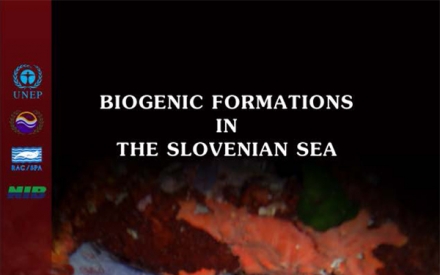Search
06/16: Just published: Biogenic formations in the Slovenian sea
This brochure on marine biogenic formations in Slovenia, now available in English, shed light on a piece of the Adriatic biodiversity hitherto unknown
It is well known that the northern Adriatic Sea is particular. This northernmost area of the Mediterranean Sea is outstanding from different points of view, due to the numerous particular characteristics such as the trezze, as they are called in Trieste or tegnùe, as they are known in Venice. Similar formations are also present in the Slovenian part of the Adriatic Sea, which are known for their immense biodiversity.
Paradoxically, fishermen from both sides of the border have been aware of such biogenic formations for centuries, while researchers discovered these valuable elements of biodiversity only recently. These small and peculiar geomorphologic formations, densely overgrown with fauna and flora, creep out of the sedimentary bottom in the form of small hills and attract a variety of economically important fish species and other animals. The fact that researchers from Slovenia and Italy have the possibility to study such hidden treasures of biodiversity in the Gulf of Trieste and the broader northern Adriatic is even more inspiring.
Up to date, the presence of trezze and similar structures has not been confirmed in the Slovenian part of the Adriatic; however, there are other kinds of structures of biogenic origin (biogenic formations). One such biogenic formation is located in front of Cape Ronek, not far from the Nature Reserve of Strunjan, whereas the second one is located close to the Nature Monument of Debeli rtič. Both biogenic formations are large-sized, since they are almost 200 m long and both are made of dead Mediterranean stony coral (Cladocora caespitosa) corallites. Underwater sampling revealed an immense biodiversity, hosted by both giant platforms; a high density of stony coral colonies and the giant brain sponge (Geodia cydonium), a huge diversity of benthic invertebrates and many coralline algae. Taking into account the diverse fish fauna, the importance of biogenic structures is even more significant.
Although SCUBA diving researchers have discovered many new, less known and rare species associated with biogenic formations, we are certain that future research will substantially enlarge the checklist of species. In addition, further research will improve our understanding of ecological relationships, patterns and processes related to biogenic formations, and also ellucidate the impact of anthropogenic activities on such benthic communities.
This book provides a general overview of the biodiversity of biogenic formations in Slovenia. It is not an ultimate survey of fauna and flora. The aim is to inspire researchers of marine life in the northern Adriatic and other Mediterranean areas, scientists from other fields of life sciences and SCUBA divers, to study biogenic formations and coralligenous biocoenoses in an attempt to reveal their hidden treasures and mysteries.
The authors : prof. dr. Lovrenc LIPEJ, dr. Martina ORLANDO-BONACA and dr. Borut MAVRIČ
*The document "Biogenic formations in the Slovenian sea" has been translated into English and printed within the framework of the "Project on Mapping of key marine habitats in the Mediterranean and promoting their conservation through the establishment of Specially Protected Areas of Mediterranean Importance (SPAMIs)” (MedKeyHabitats Project). This Project is implemented with the financial support of MAVA foundation.




Find Us On...